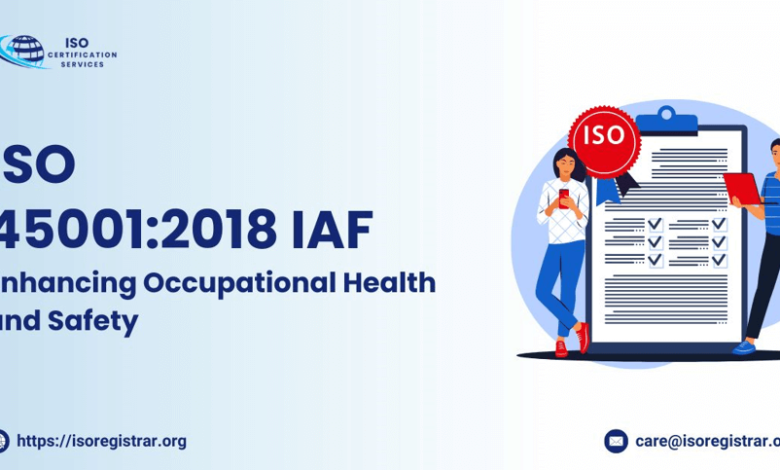ISO 45001: 2018 IAF: Enhancing Occupational Health and Safety

In today’s rapidly evolving industrial landscape, ensuring the health and safety of workers is paramount. ISO 45001: 2018, developed by the International Organization for Standardization (ISO), is a globally recognized standard dedicated to Occupational Health and Safety (OH&S) management systems. It provides a framework that helps organizations enhance their OH&S performance, mitigate risks, and foster a safer working environment. The International Accreditation Forum (IAF) plays a crucial role in accrediting certification bodies that assess organizations’ compliance with ISO 45001: 2018.
Understanding ISO 45001: 2018
ISO 45001: 2018 specifies requirements for an OH&S management system and guides its use, enabling organizations to improve their OH&S performance proactively. The standard applies to any organization, regardless of size, type, or nature of work, and is designed to integrate seamlessly with other ISO management system standards such as ISO 9001 (Quality Management) and ISO 14001 (Environmental Management).
The standard is structured around the Plan-Do-Check-Act (PDCA) cycle, promoting continuous improvement. Key elements of ISO 45001: 2018 include:
Context of the Organization: Understanding the internal and external factors that affect the OH&S management system.
Leadership and Worker Participation: Emphasizing top management’s role in establishing a culture of safety and ensuring active worker involvement.
Planning: Identifying risks and opportunities, setting objectives, and planning actions to address them.
Support: Allocating resources, ensuring competence, and fostering awareness and communication.
Operation: Implementing processes to manage risks and achieve OH&S objectives.
Performance Evaluation: Monitoring, measuring, analyzing, and evaluating OH&S performance.
Improvement: Taking actions to enhance OH&S performance continually.
Role of the International Accreditation Forum (IAF)
The IAF is a global association of accreditation bodies and other organizations involved in conformity assessment in various fields, including OH&S. The IAF’s primary function is to ensure that accredited certification bodies are competent and reliable, thus maintaining the integrity of ISO standards.
For ISO 45001: 2018, the IAF has established specific guidelines and requirements for accreditation bodies and certification bodies to follow. These include:
Accreditation Requirements: Accreditation bodies must comply with ISO/IEC 17021-1, which sets out requirements for bodies providing audit and certification of management systems. Additionally, IAF Mandatory Documents (MDs) provide further specific requirements for ISO 45001: 2018.
Competence of Auditors: Certification bodies must ensure that auditors conducting ISO 45001 audits are competent, with a deep understanding of OH&S principles and practices. This involves rigorous training and assessment procedures.
Audit Process: The IAF mandates a structured and systematic approach to audits, ensuring they are thorough and impartial. Audits should cover the entire scope of the OH&S management system, including documentation review, on-site assessment, and interviews with personnel.
Surveillance and Recertification: Accredited certification bodies must conduct regular surveillance audits to ensure ongoing compliance with ISO 45001: 2018. Recertification audits are required at specified intervals to maintain certification.
Benefits of ISO 45001: 2018 Certification
Implementing an ISO 45001: 2018 OH&S management system and achieving certification offers numerous benefits to organizations, including:
Enhanced Worker Safety: By systematically identifying and managing risks, organizations can reduce workplace accidents and illnesses, fostering a safer working environment.
Regulatory Compliance: ISO 45001 helps organizations comply with legal and regulatory requirements related to occupational health and safety, reducing the risk of fines and legal liabilities.
Improved Reputation: Certification demonstrates a commitment to worker health and safety, enhancing the organization’s reputation among stakeholders, including customers, investors, and the community.
Operational Efficiency: A well-implemented OH&S management system can lead to operational efficiencies by reducing downtime, minimizing accidents, and improving worker morale and productivity.
Risk Management: ISO 45001 provides a structured approach to risk management, helping organizations anticipate and mitigate potential hazards before they result in harm.
Continuous Improvement: The PDCA cycle embedded in ISO 45001 fosters a culture of continuous improvement, encouraging organizations to regularly assess and enhance their OH&S performance.
Read also: Udyam Registration: Understanding the Benefits for Exporters and Importers
Challenges and Considerations
While ISO 45001: 2018 offers significant benefits, organizations may face challenges during implementation and certification:
Resource Allocation: Implementing an OH&S management system requires investment in terms of time, personnel, and financial resources. Organizations must ensure they allocate sufficient resources to effectively implement and maintain the system.
Cultural Change: Achieving ISO 45001 certification often necessitates a cultural shift within the organization, requiring strong leadership and worker engagement to foster a safety-first mindset.
Integration with Other Systems: For organizations already certified to other ISO standards, integrating ISO 45001 with existing management systems can be complex but beneficial, requiring careful planning and coordination.
Maintaining Compliance: Ensuring ongoing compliance with ISO 45001 requires continuous monitoring and improvement efforts, which can be challenging, particularly for large or decentralized organizations.
Note: Apply for ISO Certificate through the official portal.
Conclusion
ISO 45001: 2018, supported by the rigorous accreditation and certification framework of the IAF, provides a robust foundation for organizations seeking to enhance their occupational health and safety performance. By adopting ISO 45001, organizations demonstrate their commitment to safeguarding their workforce, complying with legal requirements, and striving for continuous improvement. While the certification path may present challenges, the benefits of a safer, more efficient, and reputable organization make the effort worthwhile. As workplace safety continues to gain prominence globally, ISO 45001: 2018 stands as a critical tool for organizations dedicated to protecting their most valuable asset: their people.





